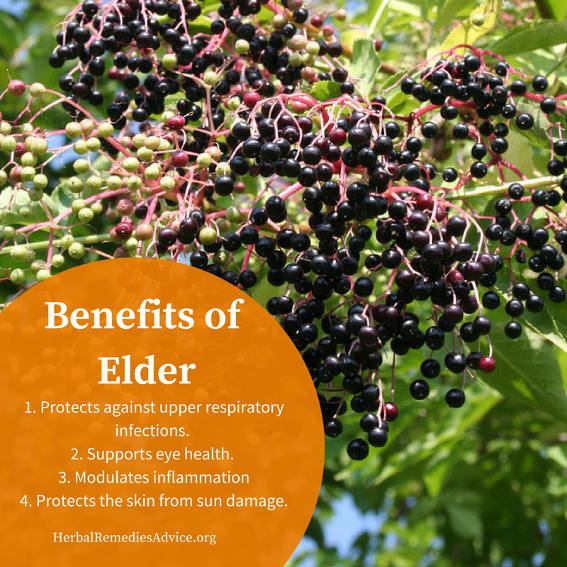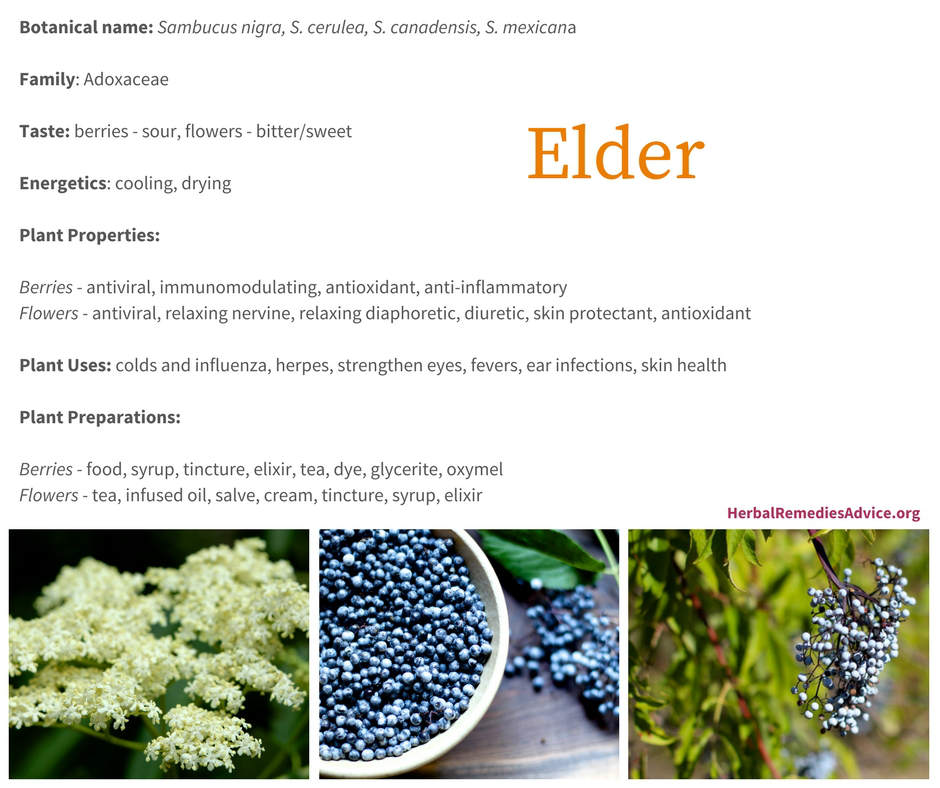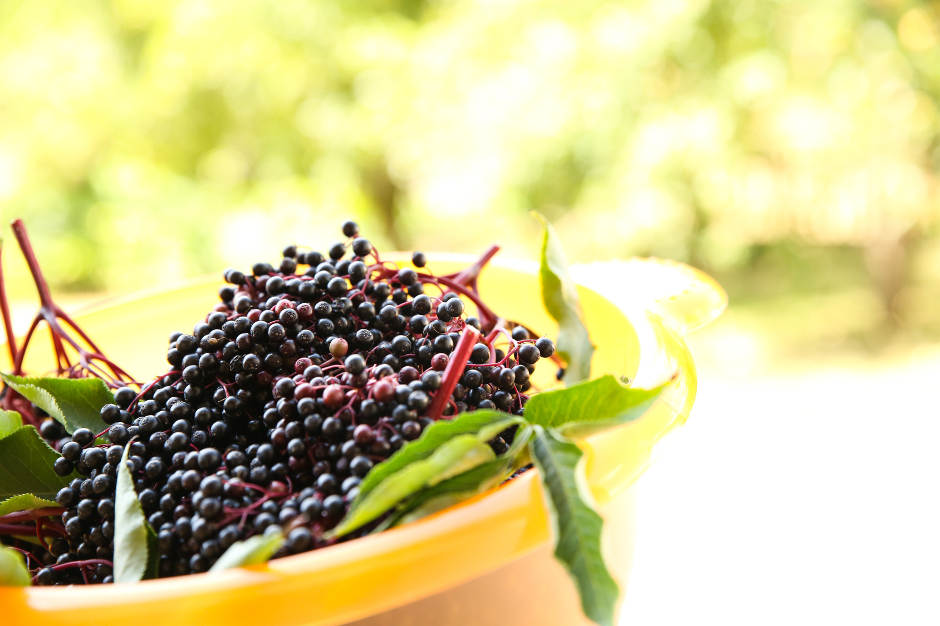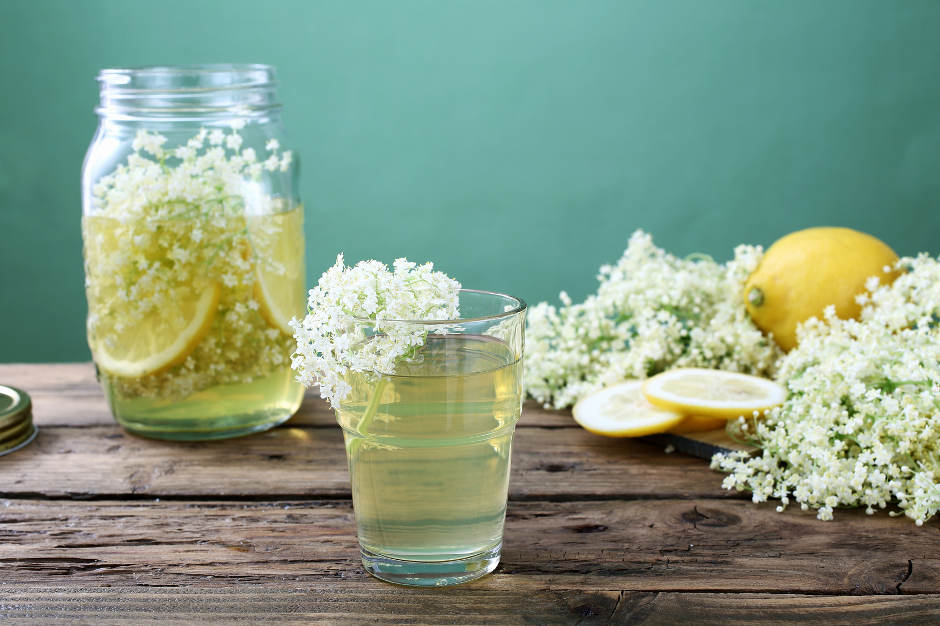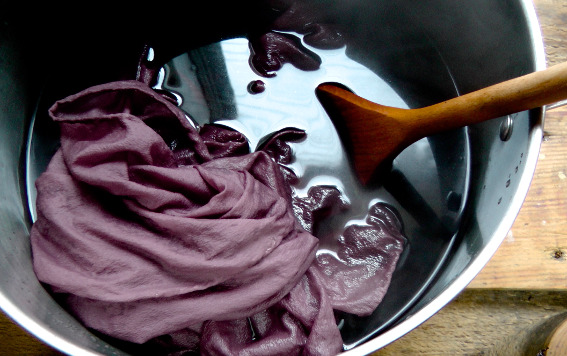Get weekly tips, recipes, and my Herbal Jumpstart e-course! Sign up for free today.

Elderberry Benefits
Share this! |
|
In my northern climate, elderberry distinctly marks each season. By late winter and early spring, the elderberry bush begins to leaf out, greening the landscape with its plentiful leaves. As summer approaches, it briefly breaks into a profusion of white blooms. During this season you can easily distinguish the shrubs from other green growths. Take note of where they are! By late summer and early fall, the shrubs will be dripping in heavy bunches of berries. While I love elderflowers for medicine, the berries remain one of my favorite herbal medicines of all.
People have been using the elder herb for thousands of years for food, medicine, and tools. It has a rich folklore and has long been associated with the faery worlds, death, and rebirth. It is still highly revered today as one of our most powerful herbs for preventing and treating colds and influenza.
Herbalists are not the only ones who are recognizing the amazing benefits of elderberry. Numerous clinical trials have been done with the berries and in 2013 the first international conference on elder was held in Columbia, Missouri. The goal of the conference was to “raise elderberry to the scientific level it deserves.”
John Evelyn, writing in praise of the Elder, says: 'If the medicinal properties of its leaves, bark and berries were fully known, I cannot tell what our countryman could ail for which he might not fetch a remedy from every hedge, either for sickness, or wounds.'
- Maude Grieve, A Modern Herbal
Elderberry Benefits: History and Folklore of Elderberry Uses
There is a long history of elderberry uses in Europe. Archeological excavations show large numbers of seeds at prehistoric sites, indicating elders were consumed during the Magdalenian era, which was 17,000 to 12,000 BP. It’s been hypothesized that the wood was probably used as well for making tools.1
Excavations have revealed ceremonial flint spearheads that were modeled after elder leaves, giving us the insight that the elder was probably revered then as it is now.
Elderberry shrubs were an important plant for the Celtic people. Celtic druids made flutes from elder to communicate with the souls of dead people. Celtic myth says that the spirits of the forest dwell in the hollow wood of the elder tree and that the white blooms in the spring symbolize the reincarnation of the dead.
During the spring in Austria and in the north of England, people would leave elder cuttings on graves. If the branches flowered then that meant the soul of the dead had joined paradise. Luckily, elder grows really well from cuttings!
Historically, almost every part of the elder bush was used for medicine, including the flowers, berries, leaves, and bark. This article will specifically look at using elder blossoms and elder berries.

Elderberry Benefits: Elder Blossoms as Herbal Medicine
Elderflowers have many uses, but they particularly shine in two areas: for fevers and to promote healthy skin. While that may seem an odd pairing, it’s not uncommon that herbs acting as relaxing diaphoretics also support the physiological functions of skin health.
Elderberry Benefits: Elderflowers as a Relaxing Diaphoretic
While mainstream culture often reaches for a pill for fevers, herbalists recognize many types of fevers and use a variety of herbs based on the kind of fever a person has.
Elderflowers excel for fevers when the person feels hot, is agitated or tense, and isn’t sweating. Drinking the warm tea encourages the capillaries to open up, thus helping to dispel excess heat from the body. A traditional tea remedy for fever that is still common today includes a blend of elderflowers, peppermint, and yarrow.
While elderflowers are ideal for this particular type of fever, I wouldn’t hesitate to use them in other feverish cold and influenza situations. The tea blend mentioned above is many people’s favorite tea to take at the onset of a cold or flu to help them shorten the duration of the sickness.
An almost infallible cure for an attack of influenza in its first stage is a strong infusion of dried Elder Blossoms and Peppermint. Put a handful of each in a jug, pour over them a pint and a half of boiling water, allow to steep, on the stove, for half an hour then strain and sweeten and drink in bed as hot as possible. Heavy perspiration and refreshing sleep will follow, and the patient will wake up well on the way to recovery and the cold or influenza will probably be banished within thirty-six hours. Yarrow may also be added.
- Maude Grieve, A Modern Herbal
Like most diaphoretics, when taken as a cool tea rather than a hot one, the diuretic effect is more pronounced, encouraging the healthy flow of urine.
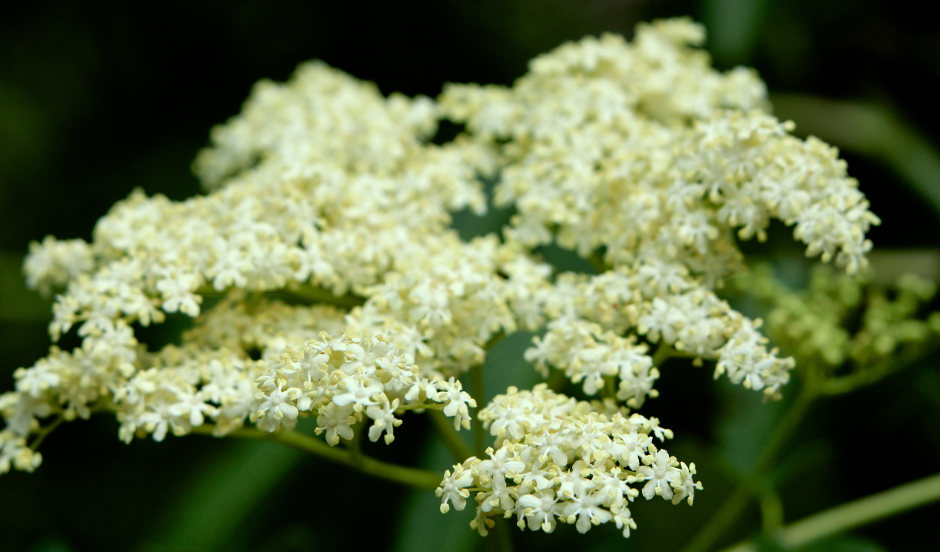 Elderberry Benefits: Elderberry Blossoms
Elderberry Benefits: Elderberry BlossomsElderberry Benefits: Elderflowers for the Skin
While elderflowers are most commonly used for fevers, they also offer many benefits for the skin. One mechanism of this action could be elderflower’s effects on the “periphery” of the body. Because a warm tea of elderflowers promotes diaphoresis, or sweating, this action moves stagnancy and can be a gentle form of natural detoxification for the skin. Elderflowers historically were often used as external preparations as a tea wash or infused in oil for a cream or salve. Elderflower washes or lotions are perfect for red and inflamed skin conditions, such as irritated rashes, sunburn, and rosacea. Elderflower water used to be a very common beauty regimen.
Recent in vitro research has shown that elderflower preparations used topically have the potential for broad spectrum UV protection.2
Elder flowers are diaphoretic and sudorific in proportion to the quantity administered, but find their principal employment in external applications, as for fomentations and poultices to swellings, and in the earlier stages of gatherings, boils, and abscesses, to discuss any collection of lymph; an ointment, also, is prepared from them, which is suitable in those cases where a cooling and emollient application is desired, as for cracks and chaps in the hands, lips, nipples of the breasts, and for similar purposes.
- John G. Hatfield, Botanic Pharmacopoeia, 1886
Elderberry Benefits: Elderflowers for Overall Health
Elderflowers can be made into a delicious tea that has broad health benefits. The resulting brews are high in phenols and other antioxidants that can protect against excess inflammation. Consider drinking elderflower tea regularly to promote eye health, cardiovascular health, and respiratory health, and to protect other systems prone to inflammation.3
The infusion is useful, and receives somewhat extensive employment, as a wash, in weakness of the eyes, dimness of vision, and twitchings of the eyelids. - John G. Hatfield, Botanic Pharmacopoeia, 1886
Other uses for elderflowers include infused oil being used for ear infections. In vitro studies have shown elderflower tea as a mouthwash to be effective against periodontal pathogens like gingivitis.4
Elderberry Benefits: Elder Berries as Herbal Medicine
Like the flowers, elderberries have myriad medicinal uses. In modern times, they are most frequently used for symptoms of upper respiratory infections. Historically, the berries were commonly used for pain and inflammation.
Elderberry Benefits: Elder Berries for Colds and the Influenza
Elderberries are renowned for their ability to prevent upper respiratory infections, as well as to shorten the duration of a cold or influenza. Using elderberries this way has stood the test of time, as many historical books record this use and modern day herbalists continue this tradition. Read my article about using elderberry for colds here.
Starting in the 1990s, this popular folkloric use caught the attention of Israeli virologist Dr. Madeleine Mumcuoglu. She began human clinical trials testing this use with astounding results. In one placebo-controlled, double-blind study, 93.3% of those taking the elderberry preparation saw a significant improvement in symptoms within two days as compared to those taking the placebo, who didn’t see improvement until six days.5
Since then a handful of studies have affirmed the benefits of elderberries against cold and influenza symptoms. In a randomized, double-blind, placebo-controlled study in Norway, researchers gave 60 patients with influenza-like symptoms of less than 48 hours either 15 mL of elderberry four times a day or a placebo syrup. On average, those receiving the elderberry syrup reported that their symptoms were relieved four days earlier than those taking the placebo. As an additional benefit, those taking the elderberry syrup reported using significantly less over-the-counter medication to relieve their symptoms.6
During the H1N1 scare of 2009, elderberries were studied in vitro and found to be effective against the virus.
How does it work?
One way that elderberries may work is due to the presence of a hemagglutinin protein. This protein has been shown to inhibit a virus’ ability to penetrate a cell wall, which then stops its ability to replicate. However, there are certainly many different mechanisms of action.
In clinical trials, patients who took the elderberry juice syrup reported fast termination of symptoms. Twenty percent reported significant improvement within 24 hours, 70% by 48 hours, and 90% claimed a complete cure after three days. Patients receiving the placebo required six days for recovery. As proof that elder has more to it than the enzyme-neutralizing constituents, researchers found that the patients who took it also had higher levels of antibodies against the flu virus.7
In my experience, elderberries can also be used to prevent a herpes breakout or to shorten the duration of a herpes breakout. This further illustrates its antiviral capabilities.
Elderberry Benefits: Elder Berries as Anti-Inflammatories
The flavonoid-rich berries are anti-inflammatory in nature and have been used to decrease arthritic or rheumatic pain, as well as for strengthening the eyes.
In 1899 an American sailor informed a physician of Prague that getting drunk on genuine, old, dark-red port was a sure remedy for rheumatic pains. This unedifying observation started a long series of investigations ending in the discovery that while genuine port wine has practically no anti-neuralgic properties, the cheap stuff faked to resemble tawny port by the addition of elderberry juice often banishes the pain of sciatica and other forms of neuralgia, though of no avail in genuine neuritis. Cases of cure have been instanced after many tests carried out by leading doctors in Prague and other centres abroad, the dose recommended being 30 grams of Elderberry juice mixed with 10 grams of port wine.
- Maude Grieve, A Modern Herbal
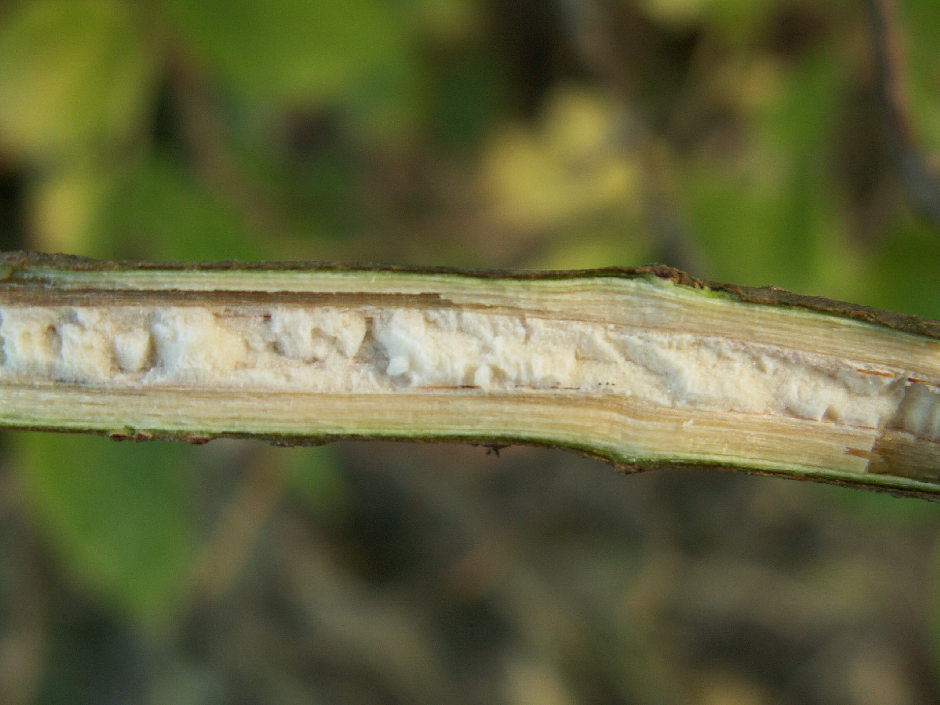 Pithy Elder
Pithy Elder Attribution: By Krzysztof Ziarnek (Own work) [GFDL (http://www.gnu.org/copyleft/fdl.html), CC-BY-SA-3.0 (http://creativecommons.org/licenses/by-sa/3.0/) or CC BY-SA 2.5-2.0-1.0 (http://creativecommons.org/licenses/by-sa/2.5-2.0-1.0)], via Wikimedia Commons
Elderberry Benefits: Elderberry Uses
Herbalists most commonly use the flowers and berries of elder, but the entire shrub has a long history of use, not only as medicine, but also for utilitarian objects and tools.
Elder wood has a pithy center. This easily hollowed out center allows for the creation of various tools and instruments, such as flutes or blow guns or pipes. Have some caution though: the pithy center of elder contains cyanide-producing glycosides that, when consumed in quantity, can cause a variety of problems, including death. Drying or boiling the materials makes them safer to use.
Some other interesting historical uses of elder include:
- Freshly crushed elder leaf placed in the nose to stop a nosebleed;
- Elder blossoms and leaves to deter moths;
- An infusion made from the leaves to expel insects and pests on plants;
- Inner bark used as a laxative and diuretic for edema, rheumatism, and gout;
- Inner bark used as an ointment for burns and herpes.
Boil the green bark till the fluid is a soft extract. Then combine with vaseline and you have an excellent salve for old sores, eczema rubrum, etc. - TJ Lyle, Physio-Medical Therapeutics, 1897
Elderberry Benefits: The Elderberry Tree
Elder trees grow as a small deciduous tree or shrub up to 30 feet tall.
The opposite leaves are pinnately divided with an odd number of opposite leaflets. The leaves often have serrated edges.
The flowers are cream colored and grow in flat umbel-shaped clusters (corymbs). Where I live the flowers tend to bloom around the 4th of July. I see my friends in Los Angeles are harvesting their flowers in January and February. In the Deep South, elder produces flowers again in the early fall.
It has been said, with some truth, that our English summer is not here until the Elder is fully in flower, and that it ends when the berries are ripe. - Maude Grieve, Modern Herbal, 1940
The flowers ripen into large clumps of dark colored berries (ranging from blue to black). There are several varieties of elders that can be interchangeably used. These include Sambucus nigra, S. canadensis, S. cerulea, and S. mexicana.
What about the red-berried elders?
The red berries of Sambucus racemosa can be used to make jams and jellies. S. racemosa has a higher content of cyanogenic compounds and should always be prepared with heat, strained of the seeds, and never eaten raw in large quantities. These red berries are mealier than the blue varieties. I’ve heard several herbalists say they use the flowers from S. racemosa the same way they use the flowers of the blue and black varieties of elders.
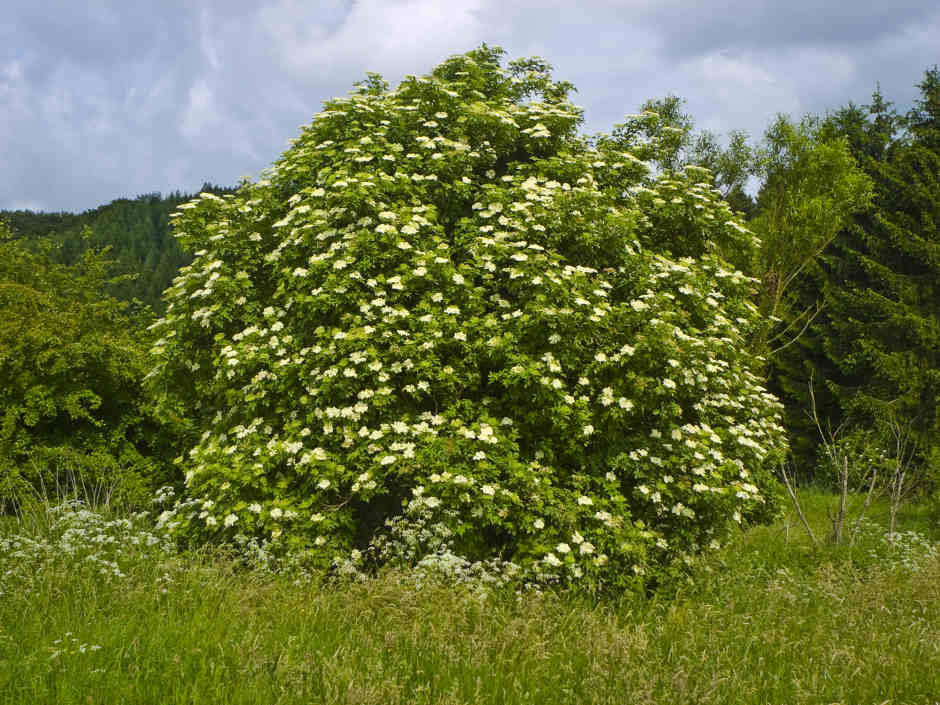 Elderberry Benefits: Elderberry Tree
Elderberry Benefits: Elderberry Tree Attribution: By Willow (Own work) [GFDL (http://www.gnu.org/copyleft/fdl.html), CC BY-SA 3.0 (http://creativecommons.org/licenses/by-sa/3.0) or CC BY 2.5 (http://creativecommons.org/licenses/by/2.5)], via Wikimedia Commons
Elderberry Benefits: Harvesting Elder Berries and Elder Flowers
Elder flowers can be harvested anytime they are in their prime. All the flowers should be a creamy white color; some may be just about to open while others in the umbel are fully opened.
Whenever I harvest elder flowers I also seem to take home a large number of small bugs. In order to encourage these bugs to find a new home, I place the freshly harvested corymbs in an open box or basket and leave them outside for a couple of hours. By the time I am ready to process the flowers into food or medicine, the bugs have flown off.
Keep in mind that every flower bunch that you harvest means that many fewer berries in the fall! Because the flowers are the reproductive organs of the plant, the berries (containing the seeds) follow after the flowers are pollinated.
Unripe (green) berries can be harvested and made into a caper-like preparation.
The ripe berries can be harvested whenever they have turned a deep blue, purple, or black color (depending on species). If you live in an area with early frosts, you could wait until the first frost to enjoy slightly sweeter berries. I harvest the berries anywhere from mid-August to mid-September. If I waited any longer the birds would be off with all of them!
Speaking of the birds, when I harvest the berries, I harvest only what I can naturally reach. This leaves many more bunches of berries for the birds and other animals to feast upon.
Both the flowers and berries can be used fresh or dried for later use.
When using fresh elderberries, the process of removing the berries from the stems can be time-consuming. Here’s is a simple trick to make the task easier. After harvesting the berry umbels, place them in a bag in the freezer. Let them sit overnight (or several hours). Once the berries are frozen you can use a fork to easily separate the berries from the stems. (You don’t have to worry if a little bit of stem gets into your tea or syrup preparation.)
Elderberry Benefits: Using Elder Blossoms
Elderflowers are commonly made into teas or taken as a tincture. When using it for an acute situation or to shorten the duration of a cold or flu, I recommend regularly taking moderate amounts throughout the day. Storing the tea in a thermos and regularly sipping it is ideal.
For external use, the flowers infuse well into oil that can be made into salves, creams, and serums.
Suggested Elderflower Dosage
Tea: 15-30 grams per day
Tincture: 30-90 drops per hour
Elderberry Benefits: Using Elder Berries
Elderberries are commonly made into syrups, decoctions, or oxymels, or eaten as food (jelly, pie, wine, etc). They also make a good tincture or elixir. As is suggested for elderflowers, when using berries for an acute situation, the best results come from using moderate dosages throughout the day. Elderberries can also be taken in small to moderate amounts as a preventive to colds and influenza.
Elderberries are food-like herbs. As long as there is no predisposed sensitivity to them, they can be liberally taken with no adverse effects (rarely, some people may find taking moderate amounts upsets their stomach). You and your family will certainly benefit from making your own elderberry syrup and products if you have seen the prices on the commercial products at the health food store!
Suggested Elderberry Dosage
Decoction/Syrup: 30-60 grams prepared as a decoction/syrup per day
Tincture: 30-90 drops per hour
Elderberries make a great dye. Depending on the method used, the berries can create a grey, purple, or black dye. It has been used to dye hair black or dye textiles like the purple silk scarves you see pictured below. Until recently, French school children used ink made from elderberries.
Read about more elderberry uses, including an elderberry cordial recipe, in Sue Kusch's article here.
Elderberry Benefits: Elderberry Side Effects
Elderberries and elderflowers are generally safe for everyone. The raw seeds can make some people nauseous if they eat too many of them. Cooking them diminishes this effect. I have heard from a couple of people that the commercially bought elderberry powder can cause vomiting (presumably due to the seeds in the powdered product).
NEW: see my article on Elderberry side effects and the coronavirus here.
Summary of Elderberry Benefits
One of my French resources says that there are so many medicinal properties within this plant, it is commonly called “the house pharmacy.” From colds and influenza, to arthritis, to beautiful skin, elderberries and elderflowers offer bountiful medicines.
Citations for Elderberry Benefits
Click to show/hide.
Rosalee is an herbalist and author of the bestselling book Alchemy of Herbs: Transform Everyday Ingredients Into Foods & Remedies That Healand co-author of the bestselling book Wild Remedies: How to Forage Healing Foods and Craft Your Own Herbal Medicine. She's a registered herbalist with the American Herbalist Guild and has taught thousands of students through her online courses. Read about how Rosalee went from having a terminal illness to being a bestselling author in her full story here.
